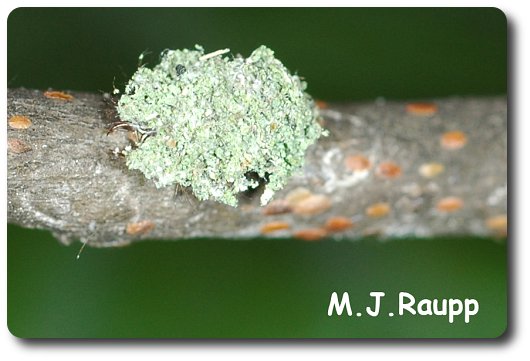In the sixth century B.C. Æsop wrote a fable about a clever wolf and a vigilant shepherd. The wolf had no luck catching sheep under the watchful eye of the shepherd. However, the crafty wolf donned a sheepskin, snuck past the shepherd into the flock, and enjoyed many tasty meals of mutton. A few weeks ago I happened to see, the entomological equivalent of the wolf in sheep's clothing, the larvae of a debris - toting lacewing. I first noticed this master of disguise as a small piece of green lichen about the size of a button on a twig.
You can see the ferocious jaws of the lacewing larva beneath its coat of plant debris.
As I watched, the animated lichen took a herky-jerky stroll down the stem. Now, lichens are usually attached to bark or a rock and they do not usually go for a walk. Upon closer inspection, I could see the lichen had small legs that propelled it and a set of wicked jaws protruding from the front end. This was the larva of a lacewing, a relative of the green lacewing we first met in the Bug of the Week episode entitled "The lion in my garden." Like their relatives, the green lacewings, these larvae are ferocious predators of many soft bodied insects like aphids and scale insects. In fact, I placed this debris - covered larva on a twig encrusted with oak lecanium scales and the predator proceeded to gobble them. Not only did it eat them, but it also took the empty carcasses of its victims and placed them on its back amidst the collection of lichens, barkchips, and other debris. What was the purpose of this? Was it some kind of macabre trophy collection of a deranged invertebrate killer? A fascinating study by the famed biologist Thomas Eisner shed some light on this unusual behavior.
Lacewing adults are active again at my porch lights, a sure sign that spring has arrived.
Most of us know the bug story about ants as guardians of aphids. Aphids provide ants with honeydew, a carbohydrate rich food, and ants protect aphids from insects that would like to eat them such as lacewing larvae. By removing the debris from the backs of the trash collecting lacewing larvae, Eisner discovered that lacewings attempting to enter an aphid colony for dinner were immediately detected by the shepherds, the ants, and tossed out of the colony and sometimes off the tree. However, when the lacewing larvae disguised themselves in debris, products made by the aphids such as wax or skins, they easily snuck past the ants and enjoyed an aphid feast much the same way Æsop's wolf snuck past the shepherd for a tasty lamb dinner. So, next time you are idly watching the bark of a tree and you see a piece of lichen go for a stroll, remember that looks can be deceiving. You may actually be watching a tiny wolf in sheep's clothing.
References:
Information for this bug of the week came from 'The love of insects' by Thomas Eisner, Belknap Press, 2003. This great book contains many fascinating stories about bugs and their strange little lives.


